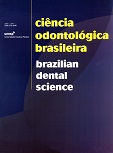Assessment of marginal sealing in indirect resin composite restorations
DOI:
https://doi.org/10.14295/bds.2009.v12i3.626Resumo
The aim of this study was to evaluate the sealing of indirect resin restorations cemented with three different luting agents. Thirty bovine teeth were used. Box type cavities preparations were made in the middle third of the buccal face. The cavities were restored with inlay restorations by the direct/indirect technique using resin composite Resilab (Wilcos, Petrópolis, RJ, Brazil). The teeth were randomly divided into three groups: Group 1: etched with 37% phosphoric acid for 30 seconds, adhesive system Prime Bond 2.1 and Enforce resin cement (Dentsply, Petrópolis, RJ, Brazil); Group 2: etched with 37% phosphoric acid for 30 seconds, adhesive system Single Bond and RelyX ARC resin cement (3M ESPE, St Paul, MN, USA); and Group 3: resin-modified glass ionomer cement RelyX Unicem Aplicap (Dentsply, Petrópolis, RJ, Brazil). The indirect restorations were cemented with the respective cements and thermal cycled for 800 cycles. The specimens were stored in 50% silver nitrate dye for 24 hours, after this procedure the teeth were sectioned in the bucco-lingual direction into 3 slices of 1 mm thick, fixed on a glass slide and then analyzed by a stereomicroscope were was coupled a digital camera to register the images. From these pictures, the marginal leakage areas were measured by the software Image Tool 3.0. The data obtained were submitted to the ANOVA and Tukey tests. ANOVA showed that there was no significant difference (p=0.73) among groups (mean values(±SD): Group 1=0.96(±0.71); Group 2: 1.10(±0.63) and Group 3: 0.99(±0.35) . It was concluded that the 3 luting agents presented no significance regarding marginal microleakage, demonstrating similar performance in the proposed research situation.
Downloads
Downloads
Publicado
Como Citar
Edição
Seção
Licença
TRANSFERÊNCIA DE DIREITOS AUTORAIS E DECLARAÇÃO DE RESPONSABILIDADE
Toda a propriedade de direitos autorais do artigo "____________________________________________________________________" é transferido do autor(es) para a CIÊNCIA ODONTOLÓGICA BRASILEIRA, no caso do trabalho ser publicado. O artigo não foi publicado em outro lugar e não foi submetido simultaneamente para publicação em outra revista.
Vimos por meio deste, atestar que trabalho é original e não apresenta dados manipulados, fraude ou plágio. Fizemos contribuição científica significativa para o estudo e estamos cientes dos dados apresentados e de acordo com a versão final do artigo. Assumimos total responsabilidade pelos aspectos éticos do estudo.
Este texto deve ser impresso e assinado por todos os autores. A versão digitalizada deverá ser apresentada como arquivo suplementar durante o processo de submissão.




























